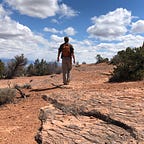Biba Guam! Biba Liberacion!
Today, July 21, marks the anniversary of the Liberation of Guam during World War II. Immediately following the surprise attack on Pearl Harbor, 6,000 Japanese marines and infantry soldiers, supported by four heavy cruisers, four destroyers, and two minesweepers, landed on the American territory of Guam. While the Japanese were conducting landings at Tumon Bay, Talofofo Bay, and the coastline near Merizo, Japanese aircraft from Saipan attacked the Marine Barracks, Navy Yard, radio station, fuel farm, and Pan American Hotel.
Defending the island were only 547 U.S. Marines and sailors and a small local militia armed only with handguns. In accordance with the Washington Naval Treaty, the United States had not improved fortifications for the previous two decades. Guam’s coastal defense artillery was removed in 1930 and the Marine seaplanes we transferred away in 1931. Nonetheless, the Japanese incorrectly believed Guam to be defended by a much stronger force, and this error caused them to use overwhelming force against the undermanned and cutoff Americas.
On December 10th, another landing was completed on Dungcas Beach, and at 5:00 that morning, the Japanese troops converged on the Plaza de España, built for the Spanish Colonial Governors and later used as the official residence of the Naval Governor in Hagåtña. In less than an hour, the overwhelmed American defenders had been defeated. 17 sailors and marines were killed, 35 wounded, and 406 captured following the brief battle. 4 members of the local militia were also killed and another 22 wounded.
What followed was a two-and-a-half-year occupation. The remaining population of about 23,400 was rounded up and interned by the Japanese. Many were mistreated and forced to work in harsh conditions. Estimates of the number who were murdered by the Japanese range from 600–2,000. As on other islands under Japanese control during the war, civilians also died from starvation and disease brought on by the brutal conditions of the occupation.
79 years ago today elements of the 3rd Marine Division, the 1st Provisional Marine Brigade, and the Army’s 77th Infantry Division came ashore near the Orote Peninsula to begin the difficult task of defeating the Japanese and liberating the island. 56,500 soldiers and marines would spend close to three weeks clearing the island of Japanese forces. In the end, only 1,250 Japanese lived to be captured out of a garrison of 20,000, the rest killed in fighting or suicidal Banzi charges.
Guam, Wake Island, and the Kiska and Attu islands in Alaska, are the only parts of America to have suffered enemy occupation since the War of 1812. The Aleutian Islands were recaptured in 1943, but Wake Island wouldn’t return to American control until two days after the Japanese surrender following the atomic bombing of Hiroshima and Nagasaki.
On Guam, Liberation Day remains a major holiday. On July 21, shouts of “Biba Guam! Biba Liberacion!” can be heard across the island and prayers of remembrance are offered in services at massacre sites. The sacrifice of the many, many, Guam residents who have given their lives in support of their country is celebrated. Firework shows, block parties, and a parade make this the premier holiday on the island.
Today, Guam is once again threatened by foreign powers hostile to the rules-based international order and democratic norms. Unlike in 1941, the American military continues to invest in Guam’s defense with the opening of Marine Corps Base Camp Blaz and the installation of a 360-degree missile defense system. These improvements, as well as Guam’s patriotism and commitment to serve, will protect the country and hopefully prevent a battle from being fought on American soil ever again.
Nicholas Monck is a graduate of the University of Colorado Law School. He also received an Energy, Environmental, and Natural Resources Law and Policy Certificate and a Graduate Renewable Energy Certificate from the University of Colorado. He has previously written about urban planning in the University of Colorado Law Review. Opinions expressed are his own and do not represent the views of his employer.
